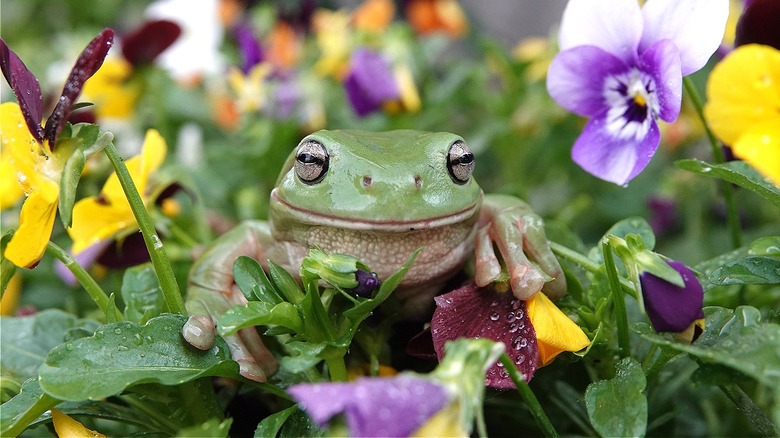Why Deterring Frogs From Your Garden Isn't A Good Idea
Frogs get a bad rap when it comes to gardeners. Some frog species are invasive and can become a nuisance, while others are poisonous, so many choose to drive frogs away. However, species like gray tree frogs and the American toad are quite helpful in a garden setting. Specifically, if you're struggling with pest infestation, driving frogs away can be a bad idea. Instead, consider welcoming this charming amphibian as a natural pest repeller.
To determine which frog species to invite to your garden, you should first learn about the species native to your region. Invasive species aren't recommended guests. You can also identify any you spot in your garden by taking an identification quiz, like this frog quiz from the United States Geological Survey. Once you know who's friend and who's foe, you can ensure only the helpful frog species get to stay in your garden space. By making a few amphibian-friendly accommodations, you can encourage these frogs (and toads) to visit your garden and take care of your pests for you.
Frogs are great exterminators
Frogs and toads can be an excellent, natural solution for treating garden pests, including slugs, snails, and mosquitoes. Despite their size and jovial appearance, these amphibians are effective predators. Frogs, for example, eat around five insects a day. To give you an idea, pet frogs are typically given three to five insects per feeding (which lasts about 10 minutes), so you can do the math for your garden frogs. Note that toads can consume far more, given their larger mouths. According to the U.S. Department of Agriculture (via The National Wildlife Federation), one American toad can eat 10,000 insects in one summer season.
Further, unlike chemical pest solutions, frogs and toads don't harm the environment or render crops like vegetables and fruits inedible. Additionally, most species are harmless to humans and are enjoyable to observe. Rather than deter frogs and toads, you can encourage them to stay in your garden instead and provide free pest control. This method relies upon nature to run its course and, therefore, is more sustainable than repeated pest treatments.
How to make your froggy friends comfortable
To encourage species like the American toad or gray tree frog to stay in your garden, you must create safe and comfortable surroundings. You can do that by adding a water source like a small pond or another shallow pool of water. Amphibians like to spend half of their time soaking in water and prefer chemical-free water. Rainwater is perfectly acceptable, as is spring water.
Further, frogs need hiding spots and shelter to avoid predators and the elements. Natural features such as rocks, logs, or piles of leaves offer protection from larger animals and serve as comfortable resting places. You can also craft a frog house from broken clay pots and other cozy containers. Frog houses are great for keeping your little helpers safe, and with some creativity, they can become decorative pieces in your garden.
When designing a frog haven, you should also add native foliage to their space. Native plants that attract insects, such as wildflowers or herbs, will also encourage frogs to stay awhile. Bringing more bugs into your garden may sound counterintuitive, but remember, these tiny creatures can eat a lot. Native plants attract more insects than non-native ones, so adding them to your garden will create a tempting buffet that frogs and toads won't want to abandon.


